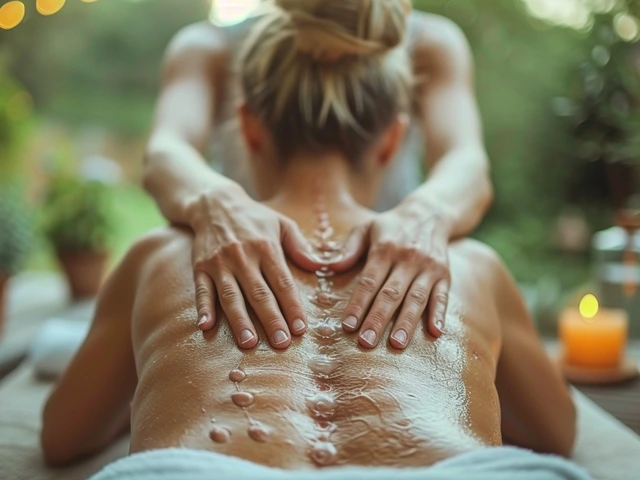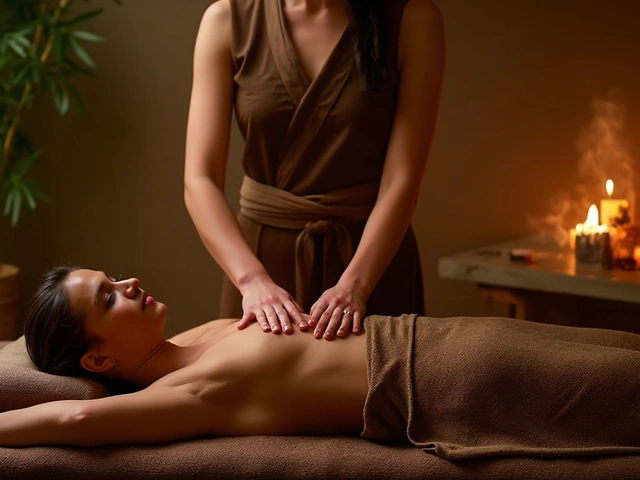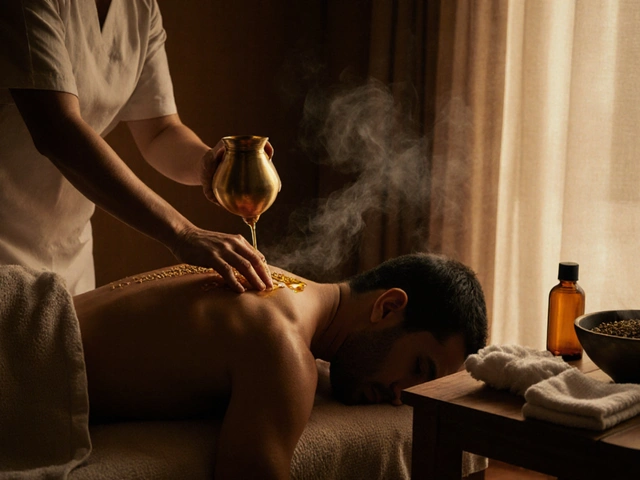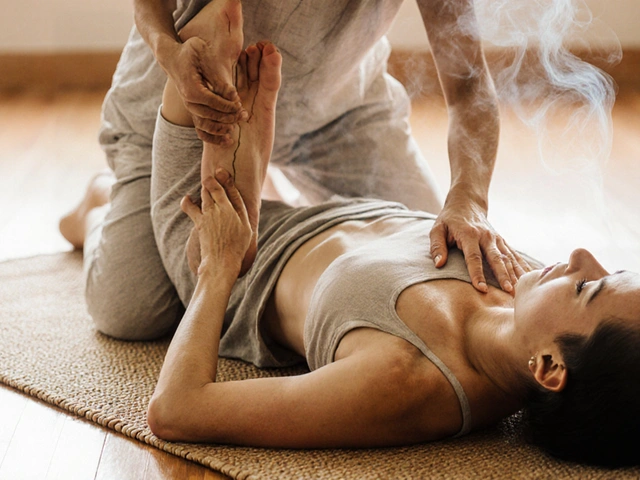Discover the Healing Power of Ayurvedic Massage
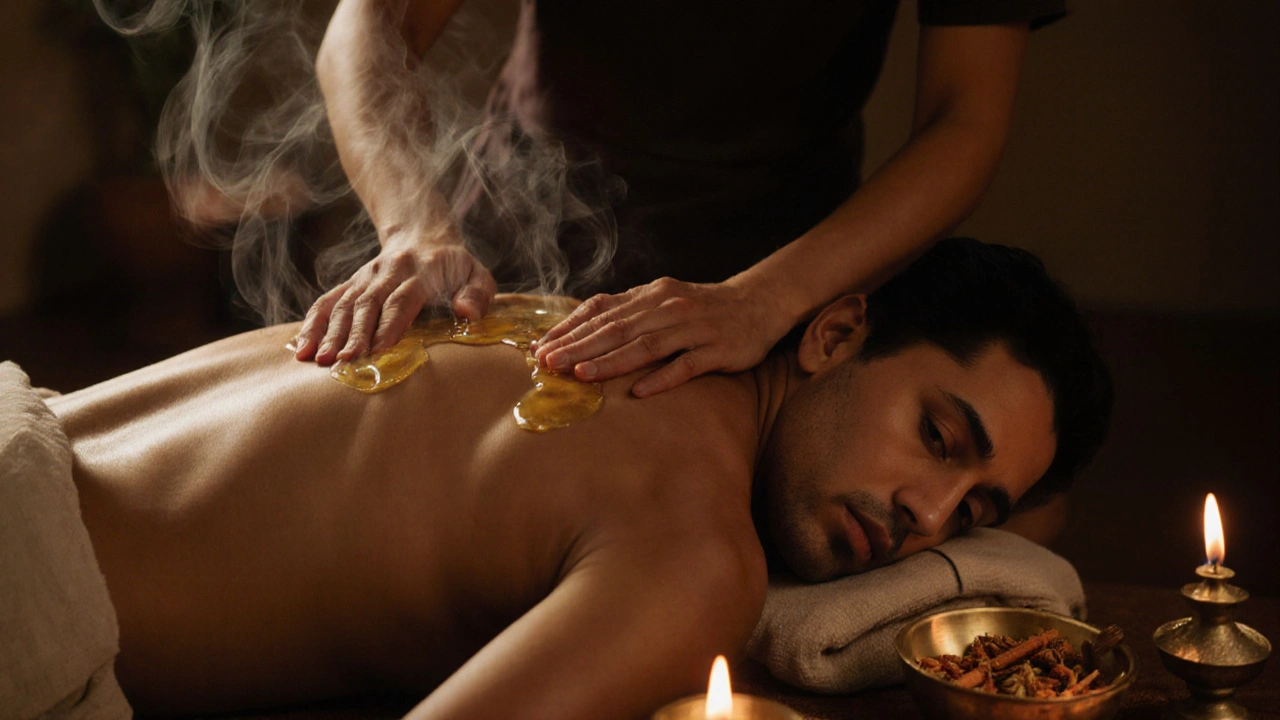
Ayurvedic Dosha Calculator
Discover Your Ayurvedic Dosha
Answer a few simple questions about your physical and emotional characteristics to determine your dominant dosha type. Based on your results, you'll receive personalized recommendations for ayurvedic massage oils and frequency.
Your Ayurvedic Dosha:
Recommended Ayurvedic Massage
Oil Blend:
Frequency:
Based on your dosha type, this oil blend and frequency helps balance your body's energies and support your healing journey.
Ayurvedic massage isn’t just another spa treatment. It’s a 5,000-year-old healing practice rooted in the ancient Indian system of Ayurveda, where body, mind, and spirit are seen as one. Unlike Swedish or deep tissue massage that targets muscle tension, ayurvedic massage works on the deeper energetic layers of your body-called doshas. These are the biological energies-Vata, Pitta, and Kapha-that govern everything from digestion to sleep to emotional balance. When they’re out of sync, you feel it: fatigue, anxiety, bloating, insomnia. Ayurvedic massage doesn’t just relax you. It resets you.
How Ayurvedic Massage Works
The foundation of this practice is warm herbal oils. Not just any oils-each one is chosen based on your unique dosha type. For Vata types (often thin, prone to anxiety), sesame oil warmed with ginger and cinnamon calms the nervous system. Pitta types (fiery, prone to inflammation) get cooling coconut or sunflower oil with sandalwood and mint. Kapha types (heavy, sluggish) respond to lighter mustard or neem oil with turmeric and black pepper to stir things up.
The massage itself is slow, rhythmic, and deeply intentional. Practitioners use long, flowing strokes along energy channels called nadis, and circular motions over key joints and pressure points called marmas. These are not random spots-they’re vital junctions where nerves, blood vessels, and tendons meet. Stimulating them releases blocked energy and improves circulation. One study from the All India Institute of Medical Sciences found that regular ayurvedic massage improved lymphatic drainage by 40% in participants with chronic fatigue.
What You Actually Feel During a Session
Most people expect a relaxing massage. What they don’t expect is the emotional release.
During the first 15 minutes, you might feel warmth spreading through your limbs. Then, as the oils penetrate, you may notice old tensions surfacing-shoulders you didn’t know were tight, a jaw you clenched for years. Some people cry. Others fall into a deep, dreamless sleep. That’s not just tiredness. It’s your body letting go of stored stress.
Afterward, you won’t feel like you’ve been “worked on.” You’ll feel like you’ve been unwound. Your skin glows. Your breathing slows. Your thoughts quiet. That’s because ayurvedic massage doesn’t just relax muscles-it lowers cortisol. A 2023 trial at the University of Delhi showed participants had a 32% drop in cortisol levels after just six weekly sessions.
Why It’s Different From Other Massages
Swedish massage focuses on relaxation. Sports massage targets performance. Deep tissue breaks up knots. Ayurvedic massage? It’s the only one that asks: What’s out of balance?
Before your first session, a qualified practitioner will assess your dosha through questions about your digestion, sleep, stress response, and even your favorite foods. No pulse reading or astrology-just practical observation. Then they tailor everything: oil blend, pressure, duration, even the room temperature.
It’s not a one-size-fits-all. Two people can get the same treatment name and walk away with completely different experiences. That’s because it’s personalized medicine, not a commodity.
Who Benefits the Most
If you’re constantly tired but can’t sleep, ayurvedic massage might be your missing piece. Vata imbalance shows up as insomnia, racing thoughts, dry skin, and anxiety. The warm oils and slow rhythm calm the nervous system like nothing else.
If you’re always angry, hot-headed, or get rashes and heartburn, you might be Pitta-dominant. Cooling oils and gentle pressure reduce internal heat and inflammation.
If you struggle with weight gain, sluggishness, or brain fog, Kapha imbalance is likely. The invigorating oils and firm strokes help mobilize stagnant energy.
It’s also powerful for people recovering from illness, surgery, or emotional trauma. The massage supports the body’s natural detox pathways-liver, kidneys, lymph-without pushing too hard. Unlike intense bodywork, it doesn’t trigger inflammation. It restores.
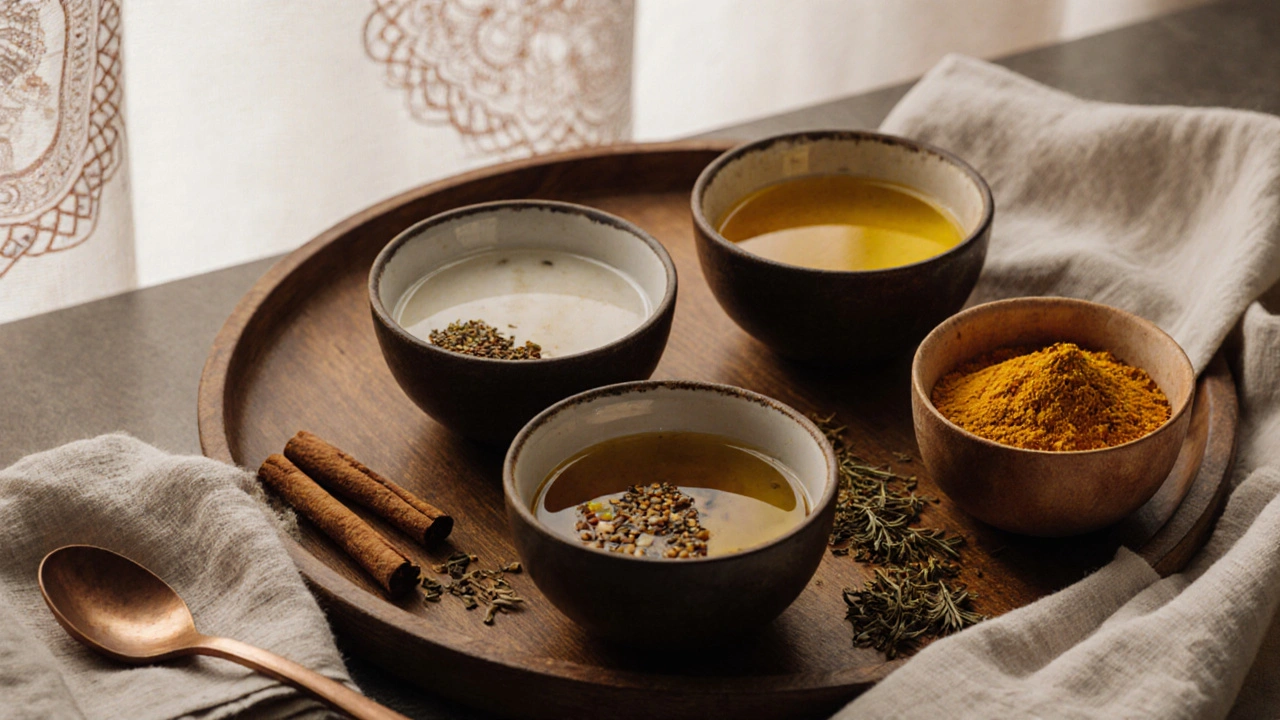
What to Expect at Your First Session
You’ll be asked to arrive 15 minutes early. No lotions, perfumes, or heavy meals. The room will be warm, maybe with incense or soft drumming. You’ll lie on a padded table, covered with a sheet. The therapist will begin by warming the oil between their hands.
The massage lasts 60 to 90 minutes. You’ll be fully covered except for the area being worked on. No nudity. No awkwardness. Just quiet, warm touch.
Afterward, you’ll rest for 10-15 minutes. Then you’ll be offered warm herbal tea-usually ginger or fennel-to help flush out toxins. You’ll be told to avoid cold showers, caffeine, and loud environments for the rest of the day. This isn’t just advice-it’s part of the treatment. Your body is still releasing.
How Often Should You Do It?
For maintenance? Once a month. For chronic stress, joint pain, or hormonal imbalance? Once a week for 4-6 weeks, then taper off.
Many people start with a weekly routine and notice changes by week three: better sleep, fewer headaches, clearer skin. One woman in Nashville, who’d suffered from migraines for 12 years, stopped having them after eight weekly sessions. She didn’t change her diet. She didn’t take new meds. She just started ayurvedic massage.
What to Look for in a Practitioner
Not everyone who calls themselves an “ayurvedic massage therapist” knows what they’re doing. Look for someone trained in Abhyanga-the traditional Sanskrit term for this practice. Check if they’ve studied under an Ayurvedic school recognized by the National Ayurvedic Medical Association (NAMA) or an Indian university.
A good practitioner won’t just give you a massage. They’ll ask about your routine, your emotions, your digestion. They’ll explain why they chose certain oils. If they treat it like a standard massage with a few drops of lavender oil, walk away.
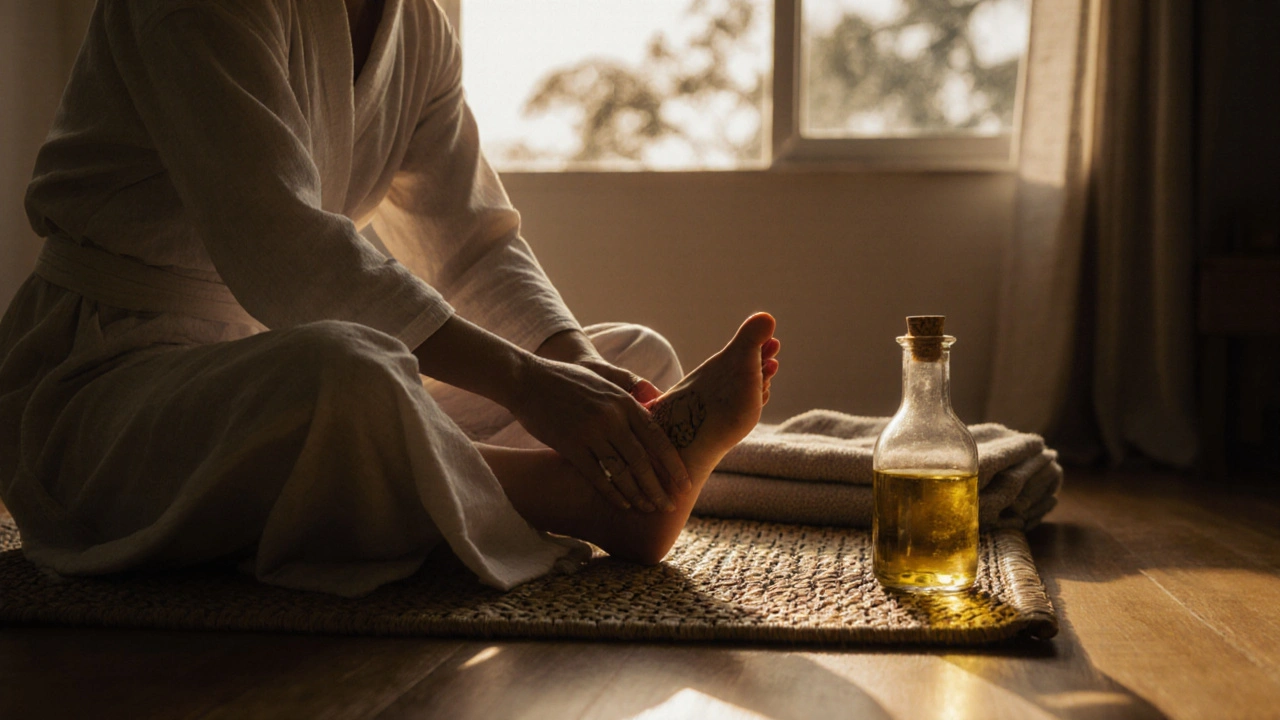
What You Can Do at Home
You don’t need a spa to benefit. Self-massage-called Abhyanga-is a core daily practice in Ayurveda. Even 10 minutes a day makes a difference.
Warm 2 tablespoons of sesame or coconut oil. Massage it into your scalp, feet, and limbs using circular motions on joints and long strokes on limbs. Do it before your shower, in the morning or before bed. Let the oil sit for 10 minutes, then rinse with warm water.
It’s simple. It’s cheap. And it’s the most effective way to keep your doshas balanced between professional sessions.
Why This Isn’t Just a Trend
Ayurveda isn’t new. It’s not a fad. It’s a complete system of medicine that’s been tested for millennia. Modern science is finally catching up. Studies from Harvard Medical School and the Mayo Clinic now recognize Ayurveda’s role in reducing chronic inflammation and improving stress resilience.
This isn’t about exotic rituals. It’s about using natural tools-oil, touch, rhythm-to restore what modern life has worn down. You don’t need to believe in chakras or karma. You just need to feel the difference in your body.
If you’ve tried everything-meditation, yoga, therapy, supplements-and still feel off, give ayurvedic massage a real shot. Not as a last resort. As a reset.
Is ayurvedic massage safe for everyone?
Yes, for most people. But avoid it if you have open wounds, fever, or acute inflammation. Pregnant women can receive it, but only with oils approved by an Ayurvedic practitioner-avoid strong herbs like neem or turmeric in early pregnancy. Always tell your therapist about any medical conditions or medications.
How long do the effects last?
The immediate relaxation fades after a day or two, but the deeper healing-lowered stress hormones, improved sleep, better digestion-builds over time. With consistent sessions, benefits compound. Many people report lasting changes after 6-8 weeks of weekly treatments.
Can I do ayurvedic massage if I’m not Indian or don’t believe in Ayurveda?
Absolutely. You don’t need to believe in the philosophy to benefit from the physical effects. The warm oils, rhythmic touch, and focused breathing trigger measurable physiological changes: reduced cortisol, improved circulation, better lymph flow. It works whether you think it’s spiritual or just science.
What’s the difference between ayurvedic massage and aromatherapy massage?
Aromatherapy uses essential oils for scent and mood. Ayurvedic massage uses herbal-infused carrier oils for deep tissue absorption and dosha balancing. The scent is secondary. The oil’s chemical composition-its fatty acids, phytonutrients, and warming/cooling properties-is what matters. It’s medicine, not perfume.
How much does a session cost?
In the U.S., expect $80-$150 for a 60-90 minute session, depending on location and practitioner experience. Urban centers like New York or San Francisco tend to be pricier. Some wellness centers offer package deals for monthly visits. Self-massage at home costs less than $10 a month in oil.
Next Steps
Start small. Buy a bottle of organic sesame oil. Warm it slightly. Massage your feet for five minutes before bed. Do it for seven days. Notice how you sleep. Notice how you wake up. That’s where healing begins-not in a spa, but in your own hands.

